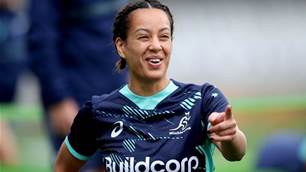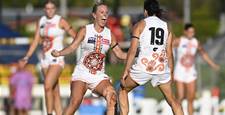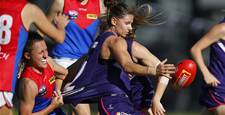Women’s rugby in this country has progressed rapidly over the last few years and Rugby Australia should be commended for going on the front foot in ensuring our elite women’s players have ample opportunity to shine at domestic and international level.
We are current Olympic champions on the back of a professional programme implemented by current sevens coach Tim Walsh.
Remarkably, we’ve also qualified for every World Cup in the fifteen-a-side game since 2006 on a shoestring budget.
Thankfully we’re not in Europe, as a more difficult route to qualify would have ensued.
If we wind back the clock to a little over a decade ago - 2003 to be exact, things were even less rosy, as the funding to the women’s high performance unit was cut by the ARU and women’s rugby went under the community rugby umbrella.
This set women’s rugby back, with no Wallaroo team gracing the international stage from 2003 to 2005 after a competitive fifth place finish at the 2002 Women’s Rugby World Cup.
Fortunately women’s rugby didn’t totally wither on the vine, as many volunteers picked up the slack of running grassroots competitions, with the strongest being the Sydney and Hunter competitions.
The ARU, to their credit, ran an invitational national championships and invited all state and territories to compete for the national title and with no Queensland competition for several years, it was often Sydney and NSW Country facing off in the national final.
During this time, our world class footballers played with little recognition, while other countries such as our Pacific neighbours New Zealand, along with the United States, Canada went from strength to strength and with many test matches being played among those countries at the time.
The Six Nations competition went from strength to strength with those countries’ players receiving plenty of press and if an Aussie player had a second passport and a parent or grandparent originally from one of those countries, no one would have begrudged an Australian player seeking fame and fortune elsewhere.
Meanwhile, our players could only look on enviously at the unlimited resources (and a few rugby league players who were enticed across by large sums of money) being thrown at the men’s game, as our Wallabies became runners-up at the 2003 Rugby World Cup.
At that time all semi-finalists and world cup champions have come from those nations, besides Australia’s exceptional performance in qualifying for the semi-finals and third place finish in 2010.
Finally, with the International Rugby Board pushing for rugby’s inclusion at the Olympics, it was finally seen that gender equity was important, as the IOC mantra save for a few established sports, was and still is the inclusion of both genders’ participation for sports at the Olympic Games.
As a result, funding and the high performance programme for the Wallaroos were brought back in 2005, but it wasn’t until 2009 when it all fell into place with our original Aussie Pearls winning the inaugural (2009) Sevens Rugby World Cup.
On the back of that success, our Wallaroos had their best ever finish with third place at the 2010 fifteen-a-side Rugby World Cup.
Key members of those squads included captain Cheryl Soon, 2009 IRB Rugby Personality (player) of the Year Debbie Hodgkinson, Alexandra Hargreaves, Tui Ormsby, Ruan Sims, Selena Worsley, Tobin Mcgann, Shelley Matcham and at the time, a young Nicole Beck and Sharni Williams before they went onto win Rio Olympic gold.
Fast forward to 2018 and Rugby Australia announced its Super W competition and for the first time in history, our fifteen-a-side players are on level terms with the traditional powerhouses of international rugby.
Those who follow rugby league have all seen how the Jillaroos went from being perennial bridesmaids in rugby league to back-to-back world champions, all due to the pathways programme being introduced at state level in NSW, coupled with the NRL taking control and preparing the national team for international competition with the best coaches and facilities money could provide.
The five team Super W competition will have access to better training facilities and some of the best coaches in the land will help female players hone their game at the elite level and this will have a flow on effect for the national team.
Most importantly the Super W competition will provide ample opportunity for young players hungry for their chance to play on the national stage and it will create a presence for female players everyone.
The biggest factor will be visibility and young girls everywhere will dare to dream and with the competition being telecast on television and women’s players representing known brands such as the Waratahs, Reds, Rebels, Force and Brumbies, role models will pop up and a largely invisible game will now become visible to the masses and most importantly young girls will be inspired to play.
We’ve already seen this happen with sevens rugby, as young girls scramble to be the next Charlotte Caslick, Elia Green, Emma Tonegato as they grow into women.
“You cannot be what you cannot see” will be a thing of the past.
Most parents will be happy with the opportunity their daughters now have if they so happen to be athletically gifted.
With both rugby codes joining the AFLW, Women’s Big Bash and W-League in a professional setting, the once traditional pathways of tennis, netball and track and field now aren’t the only pathways to fame and fortune for female athletes in this country.
Those Wallaroos who have come before including Bronnie Macintosh, Nicki Wickert, Louise Ferris, Lisa Fiaola to name a few, plus our 1994 Wallaroos - our first ever national rugby union team - who played the New Zealand Black Ferns for a 37-0 loss at North Sydney Oval... well, all these former trailblazers of women’s rugby, including those who weren’t quite good enough to play for the national team will be so proud seeing the Wallaroos improve over coming years on the world stage.
This journalist and former rugby player has already witnessed how Australia winning on the world stage in sevens rugby have already positively affected some of those who have come before.
Kudos Rugby Australia.
Related Articles

NSW banking on winning experience to go back-to-back

Code battles continue! Wallaroo joins West Coast Eagles













